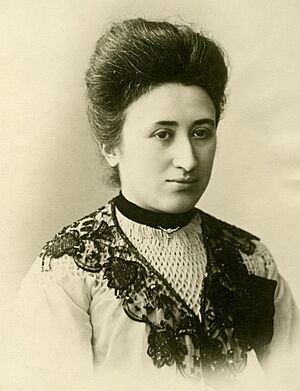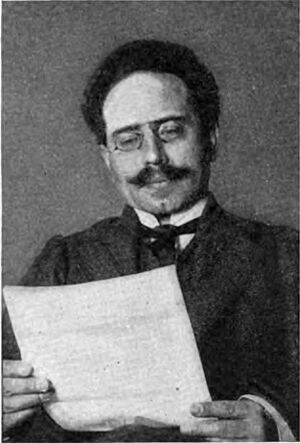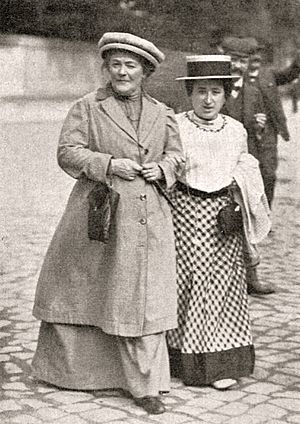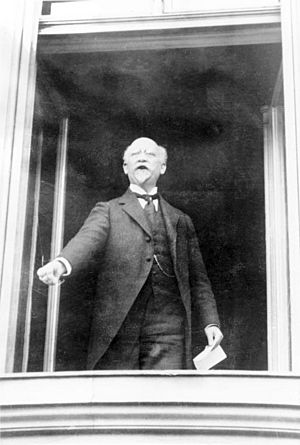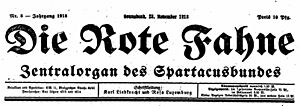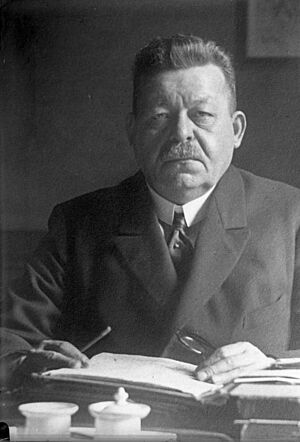Spartacus League facts for kids
Quick facts for kids Spartacus League |
|
|---|---|
| Spartakusbund | |
 |
|
| Foundation | 4 August 1914 |
| Dissolved | 15 January 1919 |
| Split from | Social Democratic Party |
| Country | |
| Motives |
|
| Ideology | Communism Marxism Revolutionary socialism |
| Political position | Far-left |
| Notable attacks | Spartacist uprising |
| Status | Defunct |
|
|
|
The Spartacus League (German: Spartakusbund) was a group in Germany that wanted big changes in society. They believed in a system called Marxism, which aims for a society where everyone is equal. This group was formed during World War I.
It started in August 1914 as the International Group. Important leaders like Rosa Luxemburg, Karl Liebknecht, and Clara Zetkin were part of it. They were members of the Social Democratic Party of Germany (SPD) but disagreed with the party's support for the war.
In 1916, the group changed its name to the Spartacus Group. Later, in 1917, they joined another party called the Independent Social Democratic Party of Germany (USPD). This party had split from the SPD because of disagreements over the war.
During the November Revolution of 1918 at the end of the war, the Spartacus Group became the "Spartacus League." They wanted to create a republic across all of Germany, where workers and soldiers would have power. On January 1, 1919, the League became part of the new Communist Party of Germany (KPD) and stopped existing as a separate group.
The League was named after Spartacus, a famous leader of a slave uprising in ancient Rome. For the Spartacus League, his name stood for the fight of ordinary people against those who exploited them. This idea was central to their belief that history is shaped by struggles between different social classes.
Contents
- What Was the Spartacus League?
- Important Members of the Spartacus League
- Images for kids
- See also
What Was the Spartacus League?
The Spartacus League was a group of people in Germany who wanted to change society. They believed in ideas from Karl Marx, which focused on creating a fairer society. They were active during and after World War I.
Why Was the Spartacus League Formed?
The League started because its founders disagreed with Germany's involvement in World War I. They felt that the war was wrong and that the main political party, the Social Democratic Party (SPD), was not doing enough to stop it.
Early Days: The International Group
On August 4, 1914, World War I began. The German parliament, called the Reichstag, voted to fund the war. Most members of the SPD voted to support the war. This decision went against what the party had promised before the war, which was to oppose such conflicts.
Rosa Luxemburg quickly gathered friends who also opposed the war. This small group, including Hermann Duncker, Hugo Eberlein, and Franz Mehring, formed the International Group. They believed the SPD had betrayed its promise to support workers across different countries.
The International Group wanted to fight against the war from within the SPD. They hoped to convince other SPD members to stop supporting the war. They also wanted to bring back the idea of workers from all countries standing together.
Becoming the Spartacus Group
In March 1915, the group tried to publish a magazine called Internationale, but it was quickly stopped by the police.
In 1916, the group grew and became known as the Spartacus Group. They published secret letters called "Spartacus Letters" that explained their goals. These letters helped spread their ideas and gave them their popular name.
By December 1915, more members of the SPD in the Reichstag started to oppose the war. Karl Liebknecht was the first to vote against war funding in December 1914. He was later expelled from the SPD in January 1916.
Joining the USPD
In April 1917, the SPD members who opposed the war formed a new party, the Independent Social Democratic Party of Germany (USPD). The Spartacus Group joined the USPD. They kept their own identity within the USPD to continue spreading their ideas.
The Spartacus Group was still a minority within the USPD. Many in the USPD were not as radical as the Spartacists, especially when it came to how to oppose the war.
Spartacus League and the Russian Revolution
The Spartacus Group was excited by the February 1917 revolution in Russia. They saw it as a victory for their own goals. However, they did not fully agree with the Bolsheviks, the group that took power in Russia.
Rosa Luxemburg and Leo Jogiches criticized the Bolsheviks' methods. They disagreed with the Bolsheviks making a separate peace treaty with Germany, called the Treaty of Brest-Litovsk. They thought this treaty would hurt the chances for a revolution in Germany and other countries.
Luxemburg also disliked the harsh actions taken by the Bolsheviks. She believed that a revolution should involve the democratic participation of workers, not just a small group of leaders. Despite these criticisms, the Spartacus Group remained independent from the Bolsheviks until they joined the KPD.
What Did the Spartacus League Want?
In October 1918, the German government made some changes to try and get a better peace deal. The Spartacus Group reacted by holding a secret meeting. They created a plan for a revolution against the war and capitalism.
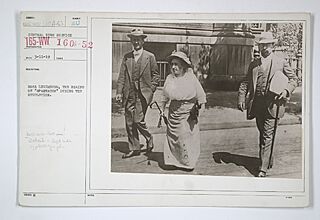
Their main demands included:
- Ending the war right away.
- Canceling all war debts.
- Gaining more democratic rights for everyone.
- Changing the justice system to be fair to all classes.
- Taking power away from the military officers.
- Making important industries, like banks and factories, owned by the public.
- Creating a socialist republic.
They especially focused on making the army more democratic. They wanted soldiers to have rights to form groups and hold meetings. They also wanted soldiers to be able to vote on their leaders.
The November Revolution and the Spartacus League
The November Revolution of 1918 started with the Kiel mutiny, where sailors refused to follow orders. Workers and soldiers then formed their own councils across Germany. These councils were not controlled by any political party.
Karl Liebknecht was released from prison in October 1918. He joined other revolutionary leaders in Berlin. On November 9, 1918, two different republics were declared in Berlin. Philipp Scheidemann of the MSPD declared "the German Republic." A few hours later, Liebknecht declared "the free socialist republic of Germany."
The Spartacus Group felt that these declarations were only a "first, quick victory." They wanted to completely get rid of the old system and create a socialist republic. They believed that the workers' and soldiers' councils should have all the power.
Re-forming as the Spartacus League
On November 11, 1918, the Spartacus Group officially re-formed as the Spartacus League. It became an independent national organization. They wanted to take power from the military, make key industries public, and create a soviet republic in Germany.
Rosa Luxemburg wrote their new plan. It called for:
- Disarming the police and the rich classes.
- Arming the working class and forming a "Red Guard."
- Workers' and soldiers' councils taking over all local and state governments.
- The public owning all banks, mines, and large businesses.
- Connecting with similar groups in other countries to spread the revolution.
The League used its daily newspaper, Die Rote Fahne (The Red Flag), to spread its ideas. They pushed for a soviet republic and for workers' councils to disarm soldiers. This was important because there had already been clashes between soldiers and supporters of the council movement.
Friedrich Ebert, the head of the temporary government, had made a secret deal with the army to stop leftist uprisings. This led to fighting on December 6, 1918.
Rosa Luxemburg wrote that the Spartacus League would only take power if the majority of working people in Germany clearly wanted them to. She believed that the victory of the Spartacus League would come at the end of the revolution, when millions of socialist workers had won.
At a meeting of workers' and soldiers' councils, only a few delegates were from the Spartacus League. The majority voted to hold elections for a new national assembly. This disappointed the Spartacists and made them want to form their own party.
Forming the Communist Party of Germany (KPD)
On December 24, 1918, there was a fight at the Berlin Palace between the government and a group of sailors. This led to deaths and caused the USPD members to leave the government.
Because of these events, the Spartacus League decided to hold a meeting on December 30, 1918, to discuss forming a new party. Many delegates arrived early, and on December 29, they decided to create a new party.
On December 31, 1918, 127 delegates formed the "Communist Party of Germany (Spartacus League)." There was a debate about the name. Rosa Luxemburg wanted "Socialist Party" to show independence from the Bolsheviks in Russia.
Another big debate was whether to take part in the upcoming elections. Rosa Luxemburg and Karl Liebknecht were in favor of participating, but others strongly opposed it. The majority voted to boycott the elections. They believed that elections for a National Assembly would not bring the true democracy that socialism aimed for.
The Spartacist Uprising and Its End
On January 5, 1919, a group of revolutionary workers in Berlin started an armed uprising. They were protesting the firing of the Berlin Police President. The KPD joined this call to action. They tried to get soldiers' councils to help overthrow Friedrich Ebert's government.
This uprising, known as the Spartacist uprising, failed. The German army and special volunteer units called Freikorps put down the uprising.
On January 15, 1919, Rosa Luxemburg and Karl Liebknecht, the two most important leaders of the Spartacus League and the KPD, were captured and murdered by members of the army. Other founders, Franz Mehring and Leo Jogiches, also died shortly after. With the deaths of these key figures, the history of the Spartacus League came to an end.
Important Members of the Spartacus League
|
|
Images for kids
See also
 In Spanish: Liga Espartaquista para niños
In Spanish: Liga Espartaquista para niños


